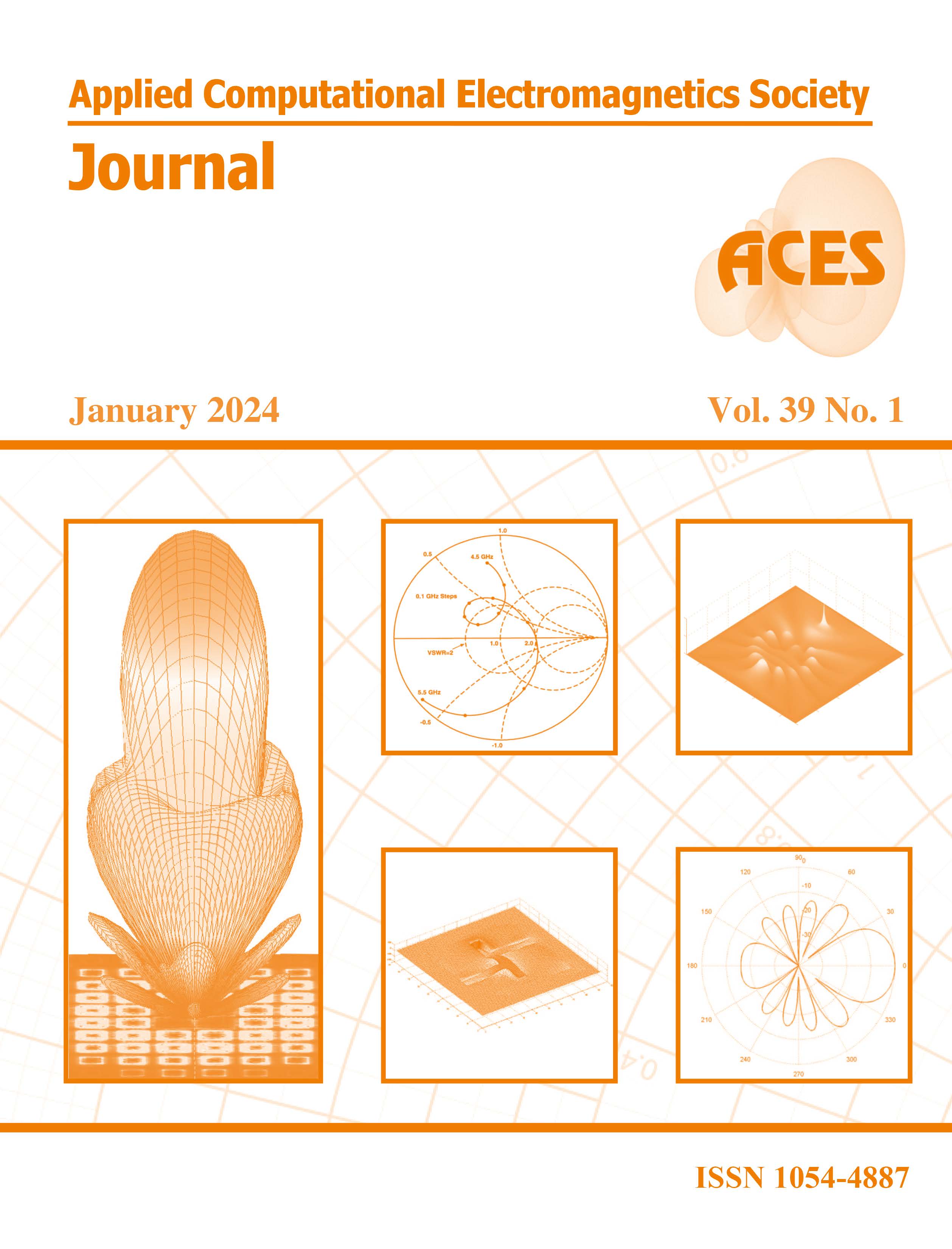A Rapid Single-view Radar Imaging Method with Window Functions
DOI:
https://doi.org/10.13052/2024.ACES.J.390101Keywords:
Radar imaging, single-view, window functionsAbstract
Monostatic rapid single-view radar imaging technology is a technique that employs single incidence angle and single frequency point information to implement rapid monostatic radar imaging within a small angular field. Owing to its analytical expression, this technique can substitute the traditional frequency-angle-scanning imaging in a small angular range, facilitating the rapid generation of highly realistic radar imaging data slices for complex targets and environments. This technology has been significantly applied in scatter hotspot diagnostics and target recognition. In order to achieve the windowing effect equivalent to that of frequency-angle-scanning imaging, and to enhance the scattering feature of monostatic imaging while controlling sidelobes, this paper derives analytic windowed imaging formulas for monostatic radar. It then obtains analytical expressions for various typical monostatic windowing rapid radar imaging scenarios. This enables the monostatic rapid imaging technology to maintain high efficiency in its analytical expressions while achieving the windowing effect equivalent to traditional imaging. The validity and correctness of the analytical formula and software implementation have been confirmed through 1D, 2D, and 3D imaging verifications. This technology can provide a vast amount of training data for modern radars.Downloads
References
N. Daryasafar, R. A. Sadeghzadeh, and M. Naser-Moghadasi, “A technique for multitarget tracking in synthetic aperture radar spotlight imaging mode based on promoted PHD filtering approach,” Radio Sci., vol. 52, no. 2, pp. 248-258, Feb. 2017.
H. Wang, Z. Chen, and S. Zheng, “Preliminary research of low-RCS moving target detection based on Ka-band video SAR,” IEEE Geosci. Remote Sens. Lett., vol. 14, no. 6, pp. 811-815, June 2017.
K. D. Singh, “Automated spectral mapping and subpixel classification in the part of thar desert using EO-1 satellite hyperion data,” IEEE Geosci. Remote Sens. Lett., vol. 15, no. 9, pp. 1437-1440, Sep. 2018.
C. Hu, L. Wang, Z. Li, and D. Zhu, “Inverse synthetic aperture radar imaging using a fully convolutional neural network,” IEEE Geoscience and Remote Sensing Letters, vol. 17, no. 7, pp. 1203-1207, Oct. 2019.
G. Xu, B. Zhang, H. Yu, J. Chen, M. Xing, and W. Hong, “Sparse synthetic aperture radar imaging from compressed sensing and machine learning: Theories, applications, and trends,” IEEE Geoscience and Remote Sensing Magazine, vol. 10, no. 4, pp. 32-69, 2022.
L. Tsang, J. A. Kong, and R. T. Shin, Theory of Microwave Remote Sensing, Wiley-Interscience, New York, 1985.
M. Yang, P. López-Dekker, P. Dheenathayalan, F. Biljecki, M. Liao, and R. F. Hanssen, “Linking persistent scatterers to the built environment using ray tracing on urban models,” IEEE Trans. Geosci. Remote Sens., vol. 57, no. 8, pp. 5764-5776, Aug. 2019.
S. K. Jeng, R. Bhalla, S. Lee, H. Ling, and D. J. Andersh, ‘‘A time-domain SBR technique for range-profile computation,” Electromagnetics Lab. Tech. Rep., Univ. of Illinois, Sep. 1993.
R. Bhalla and H. Ling, “A fast algorithm for signature prediction and image formation using the shooting and bouncing ray technique,” IEEE Trans. Antennas Propag., vol. 43, no. 7, pp. 727-731, July 1995.
R. Bhalla and H. Ling, “Image domain ray tube integration formula for the shooting and bouncing ray technique,” Radio Sci., vol. 30, no. 5, pp. 1435-1446, Sep. 1995.
O. Kechagias-Stamatis and N. Aouf, “Automatic target recognition on synthetic aperture radar imagery: A survey,” IEEE Aerosp. Electron. Syst. Mag., vol. 36, no. 3, pp. 56-81, Mar. 2021.
J. H. Cho and C. G. Park, “Multiple feature aggregation using convolutional neural networks for SAR image-based automatic target recognition,” IEEE Geosci. Remote Sens. Lett., vol. 15, no. 12, pp. 1882-1886, Dec. 2018.
Y. Sun, L. Du, Y. Wang, Y. Wang, and J. Hu, “SAR automatic target recognition based on dictionary learning and joint dynamic sparse representation,” IEEE Geosci. Remote Sens. Lett., vol. 13, no. 12, pp. 1777-1781, Dec. 2016.
X. Dai, X. Wu, B. Wang, and L. Zhang, “Semisupervised scene classification for remote sensing images: A method based on convolutional neural networks and ensemble learning,” IEEE Geosci. Remote Sens. Lett., vol. 16, no. 6, pp. 869-873, June 2019.
H. Stankwitz, R. Dallaire, and J. Fienup, “Nonlinear apodization for sidelobe control in SAR imagery,” IEEE Trans. Aerosp. Electron. Syst., vol. 31, no. 1, pp. 267-279, Jan. 1995.
F. Harris, “On the use of windows for harmonic analysis with the discrete Fourier transform,” Proc. IEEE, vol. 66, no. 1, pp. 51-83, Jan. 1978.
N. Gong and X. Xu, “GRECO based fast prediction of 3D radar images for complex targets,” 2017 Sensor Signal Processing for Defence Conference, pp. 1-5, London, UK, Dec. 2017.
X. Xu, “How to understand high resolution radar images and the pixel values of targets,” Chinese Journal of Radio Science, vol. 34, no. 1, pp. 33-44, Feb. 2019.
J. M. Jin, The Finite Element Method in Electromagnetics, Wiley, New York, 2014.
K. Ren and R. J. Burkholder, “A uniform diffraction tomographic imaging algorithm for near-field microwave scanning through stratified media,” IEEE Trans. Antennas Propag., vol. 64, no. 12, pp. 5198-5207, Dec. 2016.
Y. Li, J. Zhang, J. Niu, Y. Zhou, and L. Wang, “Computational implementation and asymptotic statistical performance analysis of range frequency autocorrelation function for radar high-speed target detection,” IEEE Trans. Comput. Imaging, vol. 6, pp. 1297-1308, Aug. 2020.
R. Bhalla, L. Lin, and D. Andersh, “A fast algorithm for 3D SAR simulation of target and terrain using Xpatch,” IEEE International Radar Conference, pp. 377-382, Arlington, VA, USA, May 2005.




